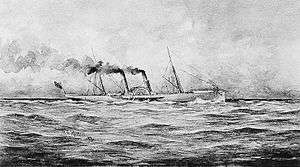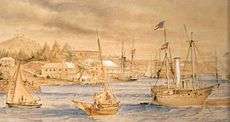Blockade runner

A blockade runner is usually a lighter-weight ship used for evading a naval blockade of a port or strait, as opposed to confronting the blockaders to break the blockade. Very often blockade running is done in order to transport cargo, for example to bring food or arms to a blockaded city. In other cases the blockade runners would carry mail in an attempt to communicate with the outside world.
Operations
Blockade runners are often the fastest ships available, and come lightly armed and armored. Their operations are quite risky since blockading fleets would not hesitate to fire on them. However, the potential profits (economically or militarily) from a successful blockade run are tremendous, so blockade-runners typically had excellent crews. Although having modus operandi similar to that of smugglers, blockade-runners are often operated by state's navies as part of the regular fleet. Notable users of blockade runners include the Confederate States of America during the American Civil War and Germany during the World Wars.
Blockade runners have always been considered enemy combatants by the blockading party and have been fired upon or captured when detected.
Blockade runners are often the subject of press coverage when they reach port, giving the act of blockade running a propaganda value.
In history
Ancient Greece, Peloponnesian War
There were numerous blockades and attempts at blockade running during the Peloponnesian War.
- With his fleet blockaded, Leon of Salamis dispatched blockade runners to seek reinforcements from Athens.
Ancient Rome, Punic Wars
During the Punic Wars, the Carthaginian Empire attempted to get around Roman blockades of its ports and strongholds. At one point, blockade runners brought in the only food reaching the city of Carthage,[1][2]
American Civil War

During the American Civil War, blockade running became a major enterprise for the Confederacy due to the Union's Anaconda Plan, which sought to cut off all the Confederacy's overseas trade. Twelve major ports and approximately 3,500 miles of coastline along the Confederate States were patrolled by some 500 ships that were commissioned by the Union government. Great Britain played a major role on the blockade running business, as they had huge investments in the south and were the recipients of many commodities exported goods, especially cotton. Great Britain also had control over many of the neutral ports in the Caribbean, as well as Atlantic ports off the East Coast of the United States, such as the Bahamas and Bermuda. To protect their interests British investors had engineered steamships that were longer, narrower and considerably faster than most of the conventional steamers guarding the American coastline, thus enabling them to outmaneuver and outrun Union ships on blockade patrol. Among the more notable of these premier vessels was the CSS Advance that completed more than 20 successful runs through the Union blockade before being captured.[3] These vessels also served to import badly needed supplies, especially firearms, and also served to bring mail to and from the Confederacy. The blockade played a major role in the Union's victory over the Confederate states. By the end of the Civil War the Union Navy had captured more than 1,100 blockade runners and had destroyed or run aground another 355 vessels.[4][5]
Cretan Revolt (1866–1869)
During the Great Cretan Revolt, Greek blockade runners supplied the Christians revolting against the Turkish rule during this time. Names of the ships include: Arkadion (named after the Arkadi Monastery, sunk by the Ottoman sloop-of-war Izzedin in August 1867);[6] Hydra; Panhellenion; and Enosis (Unification), which was detained in Syros by Hobart Pasha in December 1868, just about the time the rebellion collapsed.
Prohibition era
World War I
During World War I the Central Powers, most notably Germany, were blockaded by the Entente Powers. In particular the North Sea blockade made it nearly impossible for surface ships to leave Germany for the then neutral United States and other locations.
The blockade was run with cargo submarines, also called merchant submarines, Deutschland and Bremen, which reached the then neutral United States.[7]
The Marie successfully ran the British North Sea blockade and docked, heavily damaged, in Batavia, Dutch East Indies (now called Jakarta) on May 13, 1916.[8]
In 1918 Germany tried unsuccessfully to supply their forces in Africa by sending Zeppelin LZ104.
World War II
Axis blockade runners
On the outbreak of war, the Royal Navy imposed a naval blockade against Germany. However, the fall of France provided the German occupying forces with access to the French Atlantic coast, and between 1940 and 1942, many blockade running trips succeeded in delivering cargoes of critical war supplies - especially crude rubber - through the port of Bordeaux; a trade that increased with the entry of Japan into the war in December 1941. Allied attempts to disrupt these operations initially had only a limited effect; as in Operation Frankton. From 1943, however, improved Allied air supremacy over the Bay of Biscay rendered blockade running by surface ships effectively impossible. By some counts, during the war Germans sent 32 (surface) blockade runners to Japan, only 16 of them reaching their destination. Later in the war, most of the trade between Germany and Japan was by cargo submarine.[9]
In an attempt to transfer technology to Imperial Japan, Nazi Germany dispatched a submarine, U-234, to sail to Japan. The war ended before the ship could arrive in Japan. The Japanese submarine I-8 completed a similar mission.
On Nov. 23, 1942, the German ship Ramses attempted unsuccessfully to sail from Batavia (now called Jakarta), the ship being in the Pacific when the war started, to Bordeaux with a cargo of rubber. The hope was that maintaining a sharp 24-hour lookout they would be able to evade the Allied blockade.[10]
A small number of planes succeeded in flying between the Axis-controlled Europe and the Japanese-controlled parts of Asia. The first known flight was by an Italian Savoia-Marchetti SM.75 Marsupiale, which flew in July 1942, according to various sources, either from Zaporozhye to Baotou or from Rhodes Island to Rangoon.[9] Later, German Junkers Ju 290-A aircraft prepared for (or, according to some source, completed) similar flights.[9]
Allied blockade runners
During World War II, trade between Sweden (which remained neutral throughout the war) and Britain was severely curtailed by the German blockade of the Skagerrak straits between Norway and the northern tip of Denmark. In order to import vital materiel from Sweden, such as ball bearings for the British aircraft industry, five Motor Gun Boats, such as the Gay Viking, were converted into blockade runners, using winter darkness and high speed to penetrate the German maritime blockade.
Modern era
In modern times, tracking equipment such as radar, sonar, and reconnaissance satellites make evading a total blockade by a world power nearly impossible. Drug smugglers and groups like the Tamil Tigers are able to run blockades due to the partial nature of the blockade, or because the navy imposing the blockade is weak and under-equipped. Reminiscent of earlier German attempts, drug smugglers have used semi-submersibles (narco submarine) in their smuggling operations.[11]
See also
- Blockade runners of the American Civil War
- Blockade mail
- Captured ships of the Civil War
- Airbridge (logistics), the route and means of delivering material by an airlift, sometimes across blockades
- CSS Lark
- Merchant submarine, first invented for blockade running in World War I
- Type 4 Ka-Tsu
- Union blockade
- Smuggling
- Hobart Pasha
- Swedish overseas trade during World War II
Bibliography
- Coker, P. C., III. Charleston's Maritime Heritage, 1670-1865: An Illustrated History. Charleston, S.C.: Coker-Craft, 1987. 314 pp.
- Scharf, John Thomas (1894). History of the Confederate States navy from its organization to the surrender of its last vessel:.
Joseph McDonough, Albany, N.Y. p. 824. ISBN 1-58544-152-X. Url1 Url2 - Wyllie, Arthur (2007). The Confederate States Navys.
Lulu.com. p. 466. ISBN 978-0-615-17222-4. Url1
References
- ↑ Kern, Paul Bentley: Ancient siege warfare (p. 294)
- ↑ http://www.livius.org/ha-hd/hamilcar/hamilcar2.html
- ↑ Wyllie, 2007 p.22
- ↑ Scharf, 1894 pp.479-480
- ↑ "Confederate blockade mail". Richard Frajola, philatelist and historian . Retrieved 17 November 2010.
- ↑ Morning Post, London. 5 September 1867 citing Official Ottoman report of the incident.
- ↑ German U-boat WWI Blockade Runners
- ↑ SURVIVED BRITISH SHELLS.; German Blockade Runner, Almost a Sieve, Sailed from Africa to Java.
- 1 2 3 Harvey, A. D. (1992), Collision of Empires: Britain in Three World Wars, 1793-1945, Continuum, pp. 581–582, ISBN 1852850787
- ↑ Blockade Runner Ramses
- ↑ Colombia navy seizes submarine supected of hauling cocaine